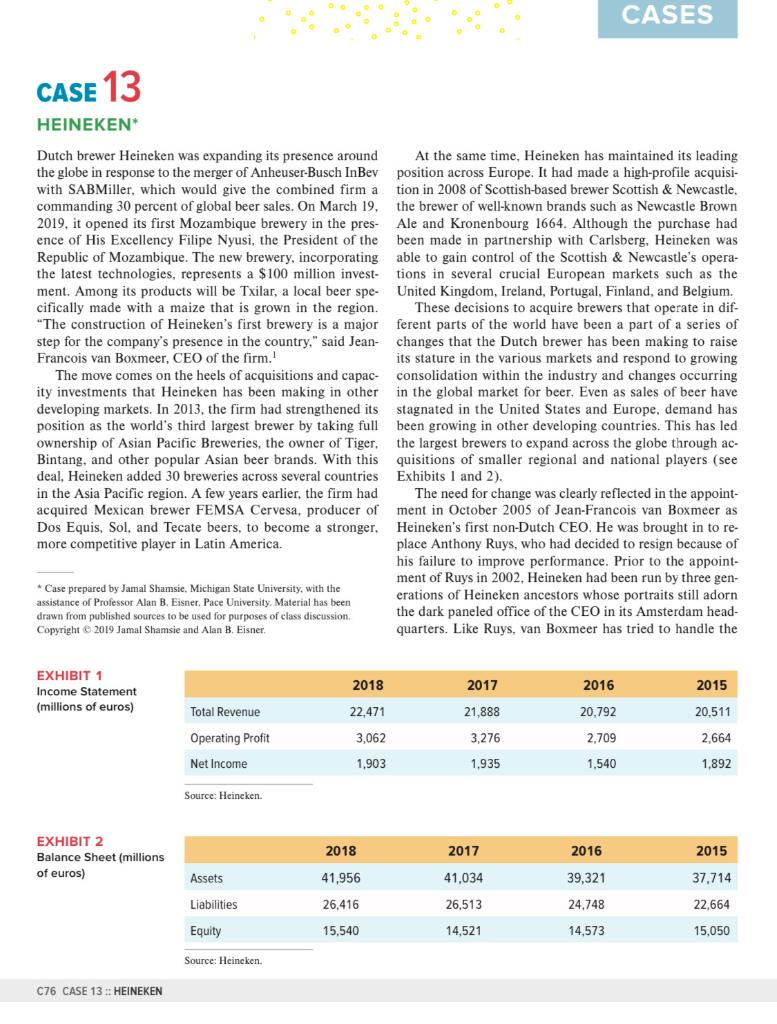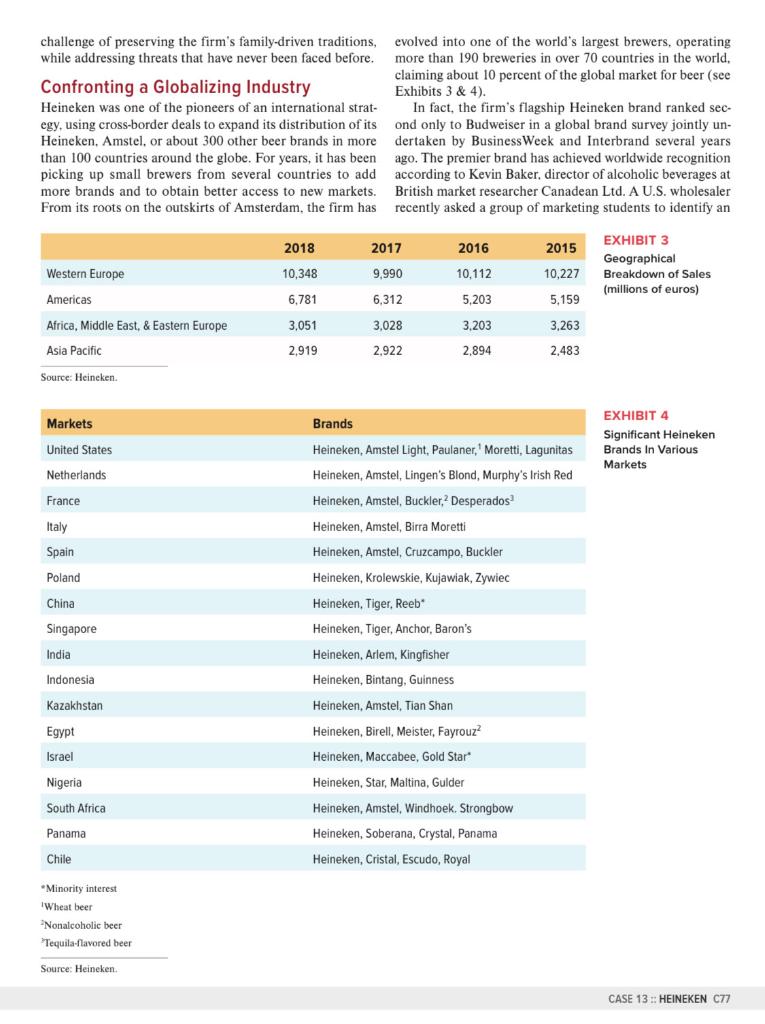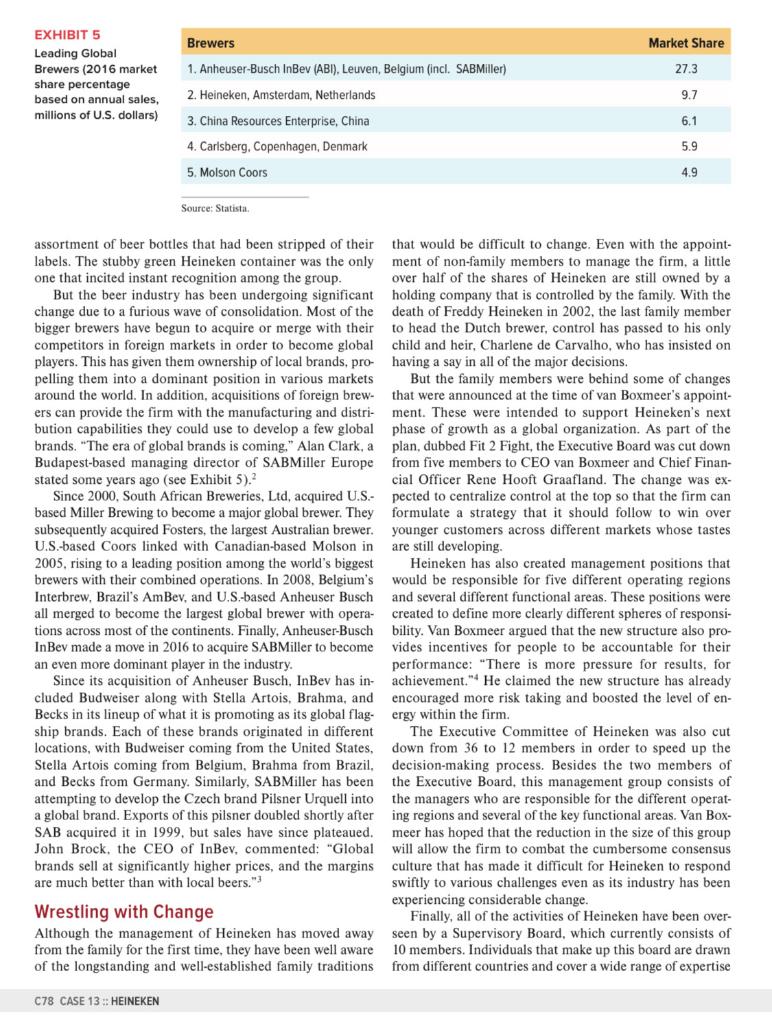: Evaluate Heinekens past organizational structure with the new structure brought in by Jean-Francois van Boxmeer. Based on the concepts from the course, what type of structure was put in place? What are the benefits? What should be their next step?




Dutch brewer Heineken was expanding its presence around At the same time, Heineken has maintained its leading the globe in response to the merger of Anheuser-Busch InBev position across Europe. It had made a high-profile acquisiwith SABMiller, which would give the combined firm a tion in 2008 of Scottish-based brewer Scottish \& Newcastle, commanding 30 percent of global beer sales. On March 19, the brewer of well-known brands such as Newcastle Brown 2019, it opened its first Mozambique brewery in the pres- Ale and Kronenbourg 1664. Although the purchase had ence of His Excellency Filipe Nyusi, the President of the been made in partnership with Carlsberg, Heineken was Republic of Mozambique. The new brewery, incorporating able to gain control of the Scottish \& Newcastle's operathe latest technologies, represents a $100 million invest- tions in several crucial European markets such as the ment. Among its products will be Txilar, a local beer spe- United Kingdom, Ireland, Portugal, Finland, and Belgium. cifically made with a maize that is grown in the region. These decisions to acquire brewers that operate in dif"The construction of Heineken's first brewery is a major ferent parts of the world have been a part of a series of step for the company's presence in the country," said Jean- changes that the Dutch brewer has been making to raise Francois van Boxmeer, CEO of the firm. 1 its stature in the various markets and respond to growing The move comes on the heels of acquisitions and capac- consolidation within the industry and changes occurring ity investments that Heineken has been making in other in the global market for beer. Even as sales of beer have developing markets. In 2013, the firm had strengthened its stagnated in the United States and Europe, demand has position as the world's third largest brewer by taking full been growing in other developing countries. This has led ownership of Asian Pacific Breweries, the owner of Tiger, the largest brewers to expand across the globe through acBintang, and other popular Asian beer brands. With this quisitions of smaller regional and national players (see deal, Heineken added 30 breweries across several countries Exhibits 1 and 2 ). in the Asia Pacific region. A few years earlier, the firm had The need for change was clearly reflected in the appointacquired Mexican brewer FEMSA Cervesa, producer of ment in October 2005 of Jean-Francois van Boxmeer as Dos Equis, Sol, and Tecate beers, to become a stronger. Heineken's first non-Dutch CEO. He was brought in to remore competitive player in Latin America. place Anthony Ruys, who had decided to resign because of his failure to improve performance. Prior to the appointment of Ruys in 2002, Heineken had been run by three gen" Case prepared by Jamal Shamsic, Michigan State University, with the assistance of Professor Alan B. Eisner. Pace University, Material has been erations of Heineken ancestors whose portraits still adorn drawn from published sourees to be used for purposes of class discussion. the dark paneled office of the CEO in its Amsterdam headCopyright 02019 Jamal Shamsie and Alan B. Eisner. quarters. Like Ruys, van Boxmeer has tried to handle the EXHIBIT 1 Income Statement (millions of euros) EXHIBIT 2 Balance Sheet (millions of euros) challenge of preserving the firm's family-driven traditions, evolved into one of the world's largest brewers, operating while addressing threats that have never been faced before. more than 190 breweries in over 70 countries in the world, Confronting a Globalizing Industry claiming about 10 percent of the global market for beer (see Heineken was one of the pioneers of an international strat- In fact, the firm's flagship Heineken brand ranked secegy, using cross-border deals to expand its distribution of its ond only to Budweiser in a global brand survey jointly unHeineken, Amstel, or about 300 other beer brands in more dertaken by BusinessWeek and Interbrand several years than 100 countries around the globe. For years, it has been ago. The premier brand has achieved worldwide recognition picking up small brewers from several countries to add according to Kevin Baker. director of alcoholic beverages at more brands and to obtain better access to new markets. British market researcher Canadean Ltd. A U.S. wholesaler From its roots on the outskirts of Amsterdam, the firm has recently asked a group of marketing students to identify an EXHIBIT 3 Geographical Breakdown of Sales (millions of euros) assortment of beer bottles that had been stripped of their that would be difficult to change. Even with the appointlabels. The stubby green Heineken container was the only ment of non-family members to manage the firm, a little one that incited instant recognition among the group. over half of the shares of Heineken are still owned by a But the beer industry has been undergoing significant holding company that is controlled by the family. With the change due to a furious wave of consolidation. Most of the death of Freddy Heineken in 2002, the last family member bigger brewers have begun to acquire or merge with their to head the Dutch brewer, control has passed to his only competitors in foreign markets in order to become global child and heir, Charlene de Carvalho, who has insisted on players. This has given them ownership of local brands, pro- having a say in all of the major decisions. pelling them into a dominant position in various markets But the family members were behind some of changes around the world. In addition, acquisitions of foreign brew- that were announced at the time of van Boxmeer's appointers can provide the firm with the manufacturing and distri- ment. These were intended to support Heineken's next bution capabilities they could use to develop a few global phase of growth as a global organization. As part of the brands. "The era of global brands is coming," Alan Clark, a plan, dubbed Fit 2 Fight, the Executive Board was cut down Budapest-based managing director of SABMiller Europe from five members to CEO van Boxmeer and Chief Finanstated some years ago (see Exhibit 5). 2 cial Officer Rene Hooft Graafland. The change was ex- Since 2000, South African Breweries, Ltd, acquired U.S.- pected to centralize control at the top so that the firm can based Miller Brewing to become a major global brewer. They formulate a strategy that it should follow to win over subsequently acquired Fosters, the largest Australian brewer. younger customers across different markets whose tastes U.S.-based Coors linked with Canadian-based Molson in are still developing. 2005, rising to a leading position among the world's biggest Heineken has also created management positions that brewers with their combined operations. In 2008, Belgium's would be responsible for five different operating regions Interbrew, Brazil's AmBev, and U.S.based Anheuser Busch and several different functional areas. These positions were all merged to become the largest global brewer with opera- created to define more clearly different spheres of responsitions across most of the continents. Finally, Anheuser-Busch bility. Van Boxmeer argued that the new structure also proInBev made a move in 2016 to acquire SABMiller to become vides incentives for people to be accountable for their an even more dominant player in the industry. performance: "There is more pressure for results, for Since its acquisition of Anheuser Busch, InBev has in- achievement. 4 He claimed the new structure has already cluded Budweiser along with Stella Artois, Brahma, and encouraged more risk taking and boosted the level of enBecks in its lineup of what it is promoting as its global flag- ergy within the firm. ship brands. Each of these brands originated in different The Executive Committee of Heineken was also cut locations, with Budweiser coming from the United States, down from 36 to 12 members in order to speed up the Stella Artois coming from Belgium, Brahma from Brazil, decision-making process. Besides the two members of and Becks from Germany. Similarly, SABMiller has been the Executive Board, this management group consists of attempting to develop the Czech brand Pilsner Urquell into the managers who are responsible for the different operata global brand. Exports of this pilsner doubled shortly after ing regions and several of the key functional areas. Van BoxSAB acquired it in 1999, but sales have since plateaued. meer has hoped that the reduction in the size of this group John Brock, the CEO of InBev, commented: "Global will allow the firm to combat the cumbersome consensus brands sell at significantly higher prices, and the margins culture that has made it difficult for Heineken to respond are much better than with local beers. 3 swiftly to various challenges even as its industry has been WrestlingwithChangeFinally,alloftheactivitiesofHeinekenhavebeenover-experiencingconsiderablechange. Although the management of Heineken has moved away seen by a Supervisory Board, which currently consists of from the family for the first time, they have been well aware 10 members. Individuals that make up this board are drawn of the longstanding and well-established family traditions from different countries and cover a wide range of expertise beers, they are developed through a more exclusive position- its existing culture. "Since 1952 history has proved it is the ing of the brand. This allows the firm to charge a higher price right concept," he stated about the Heineken's ownership for these brands. A six-pack of Heineken, for example, costs $9, structure. "The whole business about family restraint on us versus around $6 for a six-pack of Budweiser. Furthermore, is absolutely untrue. Without its spirit and guidance, the Just-drinks.com, a London-based online research service, esti- company would not have been able to build a world leader."7 mates that the market for premium beer will continue to In fact, van Boxmeer's devotion to the firm is quite eviexpand over the next decade. dent. Since he took over, Heineken has shown steady growth in revenues and profits, even with little growth in Building on Its Past the global market for beer. Before he took over as Heineken's The recent acquisitions in different parts of the world-Asia, first non-Dutch CEO, van Boxmeer had spent 20 years Africa, Latin America and Europe-represent an important working his way up within the firm. Even his cufflinks are step in Heineken's quest to build upon its existing global silver miniatures of a Heineken bottle top and opener. "We stature. Van Boxmeer and his team have made an effort to are in the logical flow of history," he explained. "Every time enter new markets and build upon the firm's position in ex- you have a new leader you have a new kind of vision. It is isting markets. In November 2018, Heineken signed an not radically different, because you are defined by what agreement with China Resources Enterprise and China Re- your company is and what your brands are." 8 sources Beer to create a long-term strategic partnership for mainland China, Hong Kong, and Macau. The partnership ENDNOTES will give the firm a 40 percent share in the Chinese firm that 1. GlobeNewswire. 2019. Heineken opens up first brewery in controls CR beer, the undisputed market leader in China, Mozambique, a US\$100 million investment. March 13. which represents the world's largest beer market. 2. Ewing, J. and G. Khermouch. 2003. Waking up Heineken. BusinessWeek, September 8, p. 68. In order to accompany this global expansion, van Box- 3. Tomlinson, R. 2004. The new king of beers. Fortune, October 18 , meer has also been committed to working on the company's p. 238. culture in order to accelerate the speed of decision making. 4. Bickerton, I. and J. Wiggins. 2006. Accelerated change is brewing at This led many people both inside and outside the firm to Heineken. Financial Times, May 8, p. 12. expect the new management to try and break loose from the 5. Ewing. J. and G. Khermouch. 2003. Waking up Heineken. conservative style that has resulted from the family's tight BusinessWeek, September 8, p. 69. 6. Kaplan, A. 2004. Border crossings. Beverage World, July 15, p. 6. control. Instead, the affable 46-year-old Belgian indicated 7. Bickerton, I. and J. Wiggins. 2006. Accelerated change is brewing at that he has been trying to focus on changes to the firm's decision-making process rather to make any drastic shifts in 8. Ibid











